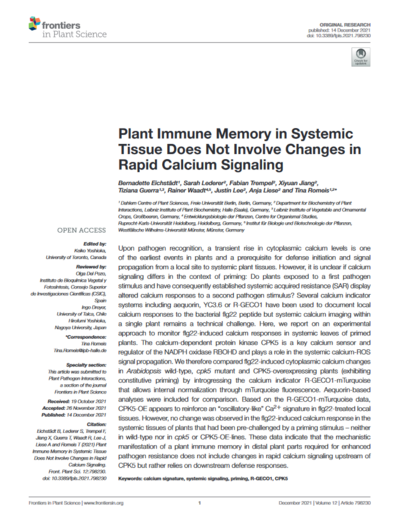Insights into rapid calcium signalling in systemic acquired resistance.
Upon pathogen recognition, plants are able defend themselves effectively, by inducing rapid cellular responses at the site of attack. One of these early signaling events is a transient rise in cytoplasmic calcium levels. It has been well known and documented how calcium levels rise in local tissues when exposed to pathogen-associated patterns such as bacterial flg22 for the first time. Until now, however, it has not been clear how calcium levels behave in distal, systemic tissues upon a second attack. A team including researchers from IPB Halle and FU Berlin has now succeeded in monitoring flg22-induced calcium responses in systemic leaves of plants that had previously been exposed to local treatment with an elicitor (so-called priming).
After a priming stimulus, plant immune memory ensures that when pathogens attack again, distal parts of the plant that had no previous pathogen contact can activate a better defense response. The researchers wanted to know whether altered calcium signaling plays a role in this systemic acquired immunity and employed a new R-GECO1-mTurquoise construct of fluorescent reporters. The R-GECO1 part visualizes calcium levels, while the mTurquoise part allows internal normalization of the reporter signal.
The research team then combined this construct with several plant lines that either lack or overexpress the key player CPK5. CPK5 acts as a very sensitive calcium sensor, but is also essential for systemic signal propagation and immune memory. While CPK5-overexpressing plants are more resistant and in a continuously primed state, cpk5 mutants are more susceptible to pathogen attack and do not show SAR immune memory. In these plant lines, calcium levels were monitored after flg22 priming and re-treatment using the fluorescent reporters.
With their experiments, the researchers were able to show that in systemic tissues, neither wild-type nor CPK5-overexpressing or -deficient plants that had previously been primed showed changes in their calcium response after flg22 treatment. Based on their results, the authors conclude that the plant immune memory evident in distal plant parts after priming seems not to rely on changes in rapid calcium signaling, but rather on downstream defense responses.
Original publication:
Eichstädt B, Lederer S, Trempel F, Jiang X, Guerra T, Waadt R, Lee J, Liese A and Romeis T (2021) Plant Immune Memory in Systemic Tissue Does Not Involve Changes in Rapid Calcium Signaling. Front. Plant Sci. 12:798230. doi: 10.3389/fpls.2021.798230



